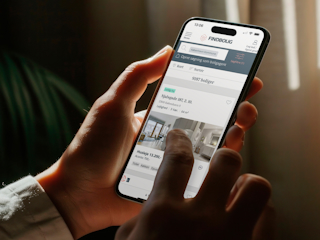junho 25, 2024
What do people remember about a great consumer experience? Not coupon codes or push notifications. They remember how the experience made them feel. Free dessert on your birthday is a nice perk, but it’s the joy of sharing that dessert with your friends that makes it memorable.
Technology makes that experience possible, of course. The restaurant’s systems have your birthday on file and surfaced that to the staff. But what makes that experience magical is the combination of technology and humanity.
Smart brands know this. Customer experience ranked as a top three investment priority for retail leaders in Valtech’s 2024 Leadership Priorities in Tech report. Done well, personalization can help you better understand your customers, build and nurture relationships based on trust and turn even the most mundane transactions into memorable experiences.
Get closer to your customer
Successful personalization strategies begin with a strong data foundation that allows you to deeply understand the preferences of your customers. Purchase history, browsing behavior and customer feedback are just a few of the useful types of information that brands can analyze to better understand what drives their customers.
Traditionally, personalization meant creating audience segments and sending out marketing campaigns via social media, third-party cookies or emails. But as consumer expectations evolve, companies are shifting toward micro-segmentation. Instead of just looking at demographics, they're considering psychographic patterns and individual preferences.
“The big challenge now is how to scale this hyper-personalization effectively,” says Ankit Jain, Data, Analytics & AI Sales Leader at Google Cloud. “That’s where generative AI steps in, helping companies manage the complexity of delivering personalized experiences at scale.”
By integrating structured data (such as purchase history) and unstructured data (such as social media interactions), it becomes possible to develop a holistic view of your customer and unlock actionable insights from that data to create natural and intuitive customer experiences.
When the tech is that powerful, the limiting factor is a business question: What value are you trying to create through personalization?
“When you start personalization by thinking about the tech, rather than thinking about the value, you're just going to tie yourself in knots. You're better focusing on what's going to give you the biggest reward, identify the data you need to execute that, and then do that one use case, start to finish.”
— Heather Ryan, Lead Data Consultant at Valtech
That means your personalization team shouldn’t be limited to technologists. Make sure you’re pulling in people across specialties, including design, product and customer service. This inclusive approach helps teams check for strategic alignment, avoid biases, spot potential issues quickly and optimize the customer experience, all while setting the stage for implementing universally beneficial designs.
"What’s really important is making sure that you’ve got a multidisciplinary team who are involved in the design of the system,” says Ewan Nicolson, Head of Data Science at Valtech. “You need human intervention throughout. You don’t need somebody babysitting the thing because you’ve designed it in such a way that equity is baked in."
And that level of care is going to become even more important as we move away from personalization solely based on records of past behavior and start using zero-party and first-party data to develop fine-grain personalization models that can adapt in real-time to changing preferences.
Consider how Chipotle uses first-party data to customize its loyalty program offerings. By 2022, 60% of promotional offers sent to loyalty members were personalized. In 2023, Chipotle expanded on this through the “Freepotle” program, which generated 10 personalized rewards throughout the year. The company gets additional data with every interaction to further tailor and personalize reward offerings and product selections during the ordering process.
Build a foundation of trust
Personalization can magnify the power of customer relationships, but it can also amplify the downsides of betrayed customer trust and lost data. Plus, bad personalization feels invasive.
"Just because you can do personalization doesn’t mean that it’s actually a better experience,” Nicolson says. “A lot of the time it can come across as a bit creepy."
To overcome that creep factor, focus on relevance and utility. Every interaction should feel to the customer like it’s a natural part of their journey.
For example, every online retailer wants to deliver relevant product recommendations to regular customers. But those marketing messages need to feel like nudges along a path they’re choosing, not one they’re being forced down. If someone buys a set of dumbbells, personalized content about resistance bands or exercise mats would likely be received positively.
If you sent that same customer personalized emails about weight-loss supplements, they may feel insulted, question how their data is being used and become disengaged.
Instead of making assumptions, design personalization programs that show why you can be trusted. Consistently tailoring offerings to individual preferences helps customers feel valued and understood—and they expect no less.
“At the end of the day, deep personalization means building a relationship with that individual consumer, understanding them at an intimate level, and then delivering value through their lens,” says Ryan Estis, who advises Fortune 1000 financial services and retail brands on customer-centered growth.
That level of empathetic personalization goes beyond merely addressing the needs of specific customer segments. It involves understanding and anticipating the diverse needs of all customers, ensuring that your personalization efforts are inclusive and beneficial to the widest possible audience.
Those two requirements might seem like a contradiction, but we can often reconcile them by borrowing from a concept in urban planning known as “the curb-cut effect,” in which accessibility-friendly changes for one group can benefit much larger audiences. (The name comes from the way that making pavement curbs accessible for wheelchairs also improved access for parents with pushchairs, delivery workers, cyclists, and many others.)
For example, a retail brand may design its app to include the option to turn on audio messages primarily to serve the visually impaired, but then find that other customers choose to activate that feature for their own reasons.
From mundane to memorable
Personalization transforms businesses by helping them deliver relevant and engaging customer experiences.
Consider the streaming recommendations you receive. When streaming platforms use your viewing history to recommend the next binge-worthy series, they’re leveraging data to make your experience seamless and engaging.
This same principle applies to countless industries. Consider agriculture, where farmers need specific, constantly updated information about weather conditions, soil health and crop cycles.
But that’s only one possible vector for personalization. A lot of marketing to farmers still relies on stereotypes, notes Michelle Filla, Global Engagement Marketing Director at Bayer’s Digital Farming organization. “How do we know that the farmers aren't turned off if we always portray them in overalls and a straw hat in our marketing content? They may not love that stereotype because it's not like that anymore.”
Personalization allows for a path to escape that trap.
“Imagine a time in the future where we capture the color of the tractor that all of the farmers have that are our customers, and they only see ads that look like themselves that look like their farms,” says Filla.
With access to that level of individual customer data, we can now achieve mass personalization at scale. When customers receive highly relevant offers and communications, this strengthens the relationship with the brand.
Personalization should feel personal. That means combining data with an understanding of your audience’s emotional needs.
Consider the financial sector, which is dominated by data but is also an extremely emotional and personal matter for clients. Banks and financial advisors already analyze client data to better understand spending habits, investing history and financial goals. The result isn’t just tailored investment recommendations based on financial principles. It’s also personalized advice based on the client’s life circumstances and goals.
Note that each of these industries uses technology to further existing relationships, not to replace them. “At the end of the day, I still am trying to create customer intimacy and get closer to my customers,” Estis says.
Consumers are increasingly looking for that level of connection across all touchpoints, whether they’re in a store or online, Ankit Jain at Google Cloud says. “This has become a table stakes expectation.”
However, it’s impossible to consistently deliver that kind of integrated experience when the data that could power it remains siloed and scattered across different parts of the organization, he says.
Even when data is brought together, it’s inconsistently used by different teams. Data analytics might drive insights, but personalization developers often lack full access. “Building a strong data foundation is critical,” Jain says.
Embrace a future of personalized experiences
Personalization blends technology, trust and empathy to meet and exceed customer expectations.
Use AI and machine learning to surface data-driven insights. Combine that with a human touch to interpret, communicate and apply those findings in meaningful ways that customers understand.
Personalized experiences should reflect customer priorities, remembering their favorite products, offering timely reminders and providing the highest levels of customer support.
Every touchpoint should demonstrate how your business understands customers and cares for them. When you achieve personalization with purpose, you’ll intentionally create interactions that are relevant, respectful and genuinely valuable — every time.










